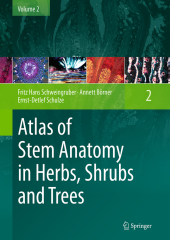 Neuerscheinungen 2016Stand: 2020-02-01 |
Schnellsuche
ISBN/Stichwort/Autor
|
Herderstraße 10
10625 Berlin
Tel.: 030 315 714 16
Fax 030 315 714 14
info@buchspektrum.de |

Annett Börner, Ernst-Detlef Schulze, Fritz Hans Schweingruber
(Beteiligte)
Atlas of Stem Anatomy in Herbs, Shrubs and Trees
Volume 2
Softcover reprint of the original 1st ed. 2013. 2016. viii, 415 S. 297 mm
Verlag/Jahr: SPRINGER, BERLIN; SPRINGER BERLIN HEIDELBERG 2016
ISBN: 3-662-52058-3 (3662520583)
Neue ISBN: 978-3-662-52058-1 (9783662520581)
Preis und Lieferzeit: Bitte klicken
This work, published in two volumes, contains descriptions of the wood and bark anatomies of 3,000 dicotyledonous plants of 120 families, highlighting the anatomical and phylogenetic diversity of dicotyledonous plants of the Northern Hemisphere.
This work, published in two volumes, contains descriptions of the wood and bark anatomies of 3000 dicotyledonous plants of 120 families, highlighting the anatomical and phylogenetic diversity of dicotyledonous plants of the Northern Hemisphere. The first volume principally treats families of the Early Angiosperms, Eudicots, Core Eudicots and Rosids, while the second concentrates on the Asterids.
Presented in Volume 2 are microsections of the xylem and phloem of herbs, shrubs and trees of 1000 species and ca. 35 families of various life forms of the temperate zone along altitudinal gradients from the lowland at the Mediterranean coast to the alpine zone in Western Europe. Special attention is given to the very diverse family of Asteraceae. The global perspective of the findings is underlined by the analysis of 400 species from the Caucasus, the Rocky Mountains and Andes, the subtropical zone on the Canary Islands, the arid zones in the Sahara, in Eurasia, Arabia and Southwest North America, New Zealand and the boreal and arctic zones in Eurasia and Canada.
The presence of annual rings in all life forms demonstrates that herbs and dwarf shrubs are an excellent tool for the reconstruction of annual biomass production and the interannual dynamic of plant associations. The common principle of the anatomical expression of secondary growth is a key factor in understanding evolution and adaptation processes in all life forms, from the 3 cm tall crepide pigmea ( Crepis pygmaea ) in the alpine zone to the 40 m tall ash ( Fraxinus excelsior ) in Central European riparian forests. The study opens vast fields of research for dendrochronology, wood anatomy, taxonomy and ecology.
1. Introduction to Volume 2
2. Monographic Descriptions
Actinidiaceae
Adoxaceae
Apiaceae
Aquifoliaceae
Araliaceae
Asteraceae
- Mutisieae
- Cardueae
- Lactuceae
- Inuleae
- Gnaphalieae
- Calenduleae
- Astereae
- Anthemideae
- Senecioneae
- Heleniae
- Heliantheae
- Eupatorieae
- Tageteae
- Summary
Balsaminaceae
Boraginaceae
Callitrichaceae
Campanulaceae
Caprifoliaceae
Clethraceae
Convolvulaceae
Cornaceae
Diapensiaceae
Diervillaceae
Dipsacaceae
Ebenaceae
Frankeniaceae
Garryaceae
Hippuridaceae
Hydrangeaceae
Lamiaceae
Lentibulariaceae
Linnaeaceae
Myrsinaceae
Oleaceae
Orobanchaceae
Plantaginaceae
Polemoniaceae
Rafflesiaceae
Roridulaceae
Sapotaceae
Sarraceniaceae
Scrophulariaceae
Solanaceae
Styracaceae
Valerianaceae
Verbenaceae
3. Ecological, Morphological, Taxonomical and Functional Significance of Stem Features Within the Dicotyledons
4. Anatomical Adaptations to Environmental Conditions
5. Ontogeny of the Xylem
6. Secondary Woodiness and Paedomorphosis
7. Conclusions
References
Alphabetic List of Species


